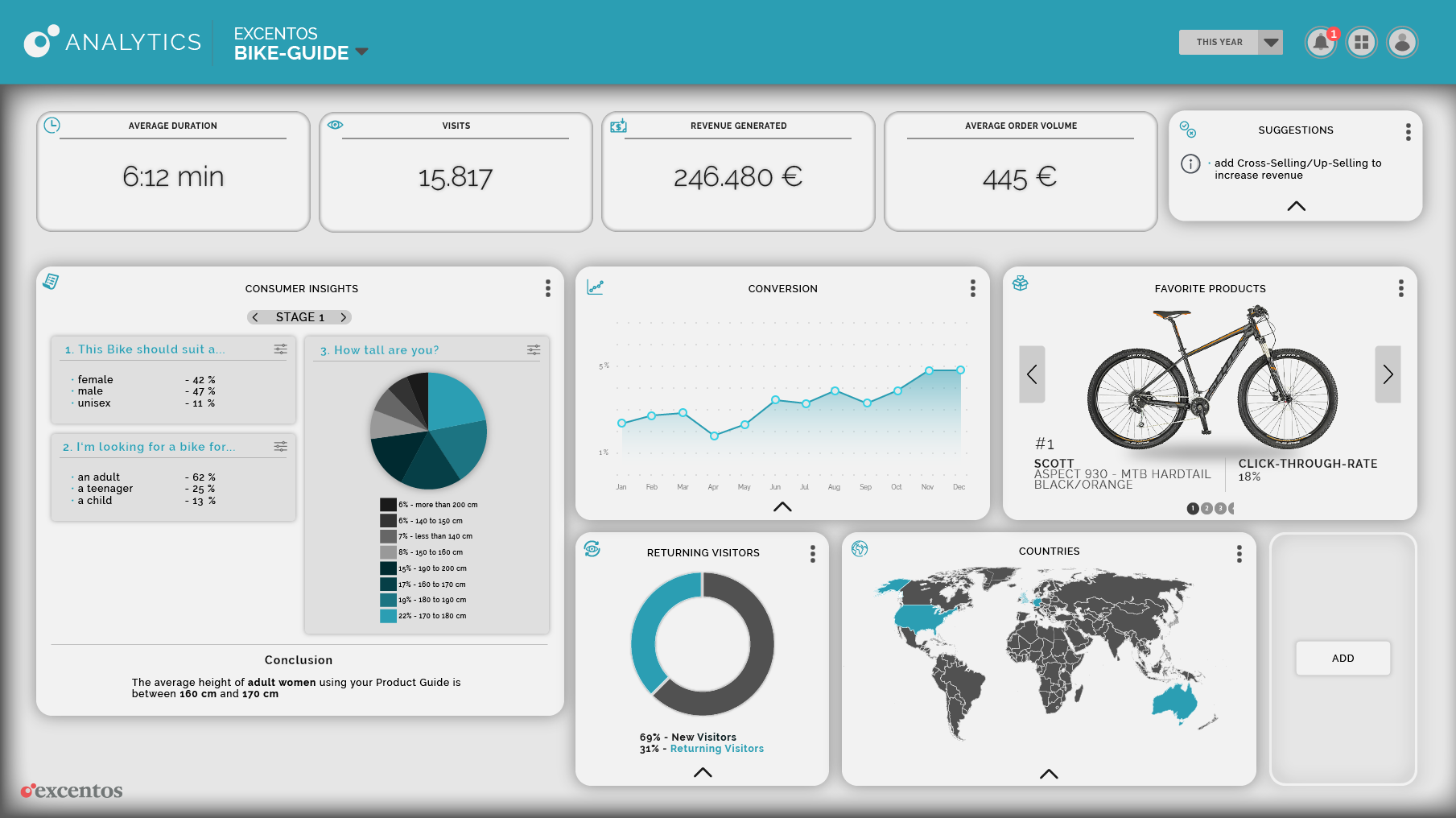Why are web analytics essential for online businesses?
Sai Naik Nimbalkar
Advantages of Website Analytics
Every website receives some form of user engagement, for e.g., a visitor clicking a link or a button or simply browsing a website or purchasing something online. Web analytics are used to measure, track and analyze such usage metrics to optimize and improve the performance of a website. They provide data that reports on how your business is performing versus its competition; insightful information about its key demographics; user behaviors and insights; the reach and impact of advertising campaigns; awareness of seasonal traffic behavior etc. to name a few. Analytics continually track such varied events and are hence capable of reporting on specific analyses across a vast range of data.
Regular analytics will give you insights, but excentos analytics offer customer insights for specific and defined aspects. Click the button to skip the introduction to web analytics and read directly about excentos analytics.
Scroll to excentos analytics1. Objectives and Goals Creation
Businesses differ on principles, objectives and plans, which are also translated to their respective websites. Websites themselves could have an objective other than just selling or even multiple different ones. Goals are used to define different parameters or steps to drive strategies based on set objectives. Analytics provide a way to set customized goals according to your website’s competencies. For e.g. A website can track how many responses they receive for their newsletter subscription or their query form. Such a goal-based approach is quite effective and methodical for optimization.
“Goals are used to define different parameters or steps to drive strategies based on set objectives.”
2. Website Visitors
Web analytics and tracking tools of course keep track of the number of visitors, as well as detailed information about the visits themselves. A user-centric overview is provided about the average time spent by visitors; how many pages were visited per user session; how many visitors are returning to the website and how often. These show the average navigation path taken by website visitors and indicates reasons a visitor might bounce. Other insightful information about demographics such as location, device, real-time reports are all essential to deliver good website functionality as well as to create a data-driven marketing strategy.
Web analytics show the number of visitors but also detailed information about the visits themselves.
3. User Acquisition
While improvements and changes are expected within a website, it is also crucial to know more about how traffic is driven to said website itself. Sources are where the users were browsing before they arrive at a particular website and medium is the method they chose to get there. For e.g. a user is browsing an external source website, sees an ad, clicks on it and navigates to a landing page of the linked website. This makes the first website the source and the cost-per-click ad a medium. This helps to know how much traffic is being generated from organic vs. paid channels and is a good indicator of how much time, effort and money should be spent on each. While search engine optimization provides organic visibility, it is also an important performance indicator as it shows the quality of a website quality and its trust ranking. When it comes to paid advertising, such insights directly impact strategies related to a websites' rate on investment.
Sources are where the users were browsing before they arrive at a particular website and medium is the method they chose to get there.
4. Behavioral Metrics
Pages on a website host different information and it is important to maintain good and relevant information to ensure quality and to keep the visitor engaged. Analytics track which pages on a website are more popular with visitors and which ones aren’t. As mentioned before, this helps maintain quality which retains visitors and is also used to measure content effectiveness. Behavior is also measured by actions taken on a website and it is valuable to see whether a site’s design is user-friendly. Analytics throw light on which pages cause the maximum bounces and contribute to a higher percentage of the bounce rate.
Behavior is also measured by actions taken on a website and it is valuable to see whether a site’s design is user-friendly.
5. Ecommerce Analytics
Ecommerce websites have a transactional or sales-focused functionality and analytical tools are configured to the core purpose of selling and revenue. Hence, tracking customer journeys can give better insights and substantially improve sales margins. More knowledge is always powerful as timely analyses and reporting enable continuous learning from customer behavior and purchases. There are also various tools that report on how a particular product or category is performing. Therefore, with customer and product-centric viewpoints, one can view an online business from different perspectives and can recognize patterns and work towards establishing a good customer relationship.
Ecommerce websites have a transactional or sales-focused functionality and analytical tools are configured to the core purpose of selling and revenue.
Advantages of excentos Analytics
A product guide leads a customer through a sales funnel that is based on insightful consumer behavior. It engages with them while asking relevant questions specific to their needs. Such an optimization tool is particularly useful for products which answer niche needs, product categories that are complicated and even large product assortments. It also targets navigation and functionality problems such as visitors browsing through countless product pages or manually setting filters to choose products. Although useful in certain circumstances, filters primarily have a functionality akin to settings. Hence, they provide a general output lacking valid reasoning and at times don't even provide results at all. A product guide on the other hand takes the consumer through a series of questions and answers, providing a valid reason at every step of the process and as a consequence, will always display a recommendation. It is also structured to reduce wasteful browsing, which stops visitors from bouncing of your website. For this reason it is an on-site optimization solution.
“A product guide leads a customer through a sales funnel that is based on insightful consumer behavior. It engages with them while asking relevant questions specific to their needs.”

Schematic repersentation of excentos Analytics
“One of the main characteristics of guided selling is optimization”
1. Consumer Insights
This shows you that out of all the traffic that clicked-through, which category of a consumer was most interested in the bikes. Furthermore, you can narrow down on segments to find out particular choices. For e.g., you could find out the average height of adults who come from a specific country and if there is any correlation with a type of bike or some other related feature.
2. Individual Event Journeys
The image used to illustrate the example gives a schematic view of excentos analytics and shows individual events such as user journeys, bounces and exit points. You can track single journeys through the funnel or get a collective view of all. Data visulizations can be changed to sift through and draw appropriate conclusions.
3. Favorite Products
It shows you which products are performing better than others and their individual click-through rates. You can evaluate product items that are not working in a particular market or segment and plan your inventory accordingly.
4. Market Information
An easy overview allows you to know if your products are getting traction in other countries, as well as comparisons between number of visitors, revenue, clicks, popularity and other such parameters.
5. Improvement Suggestions
As it learns from customer data, excentos analytics provides helpful suggestions and steps you can use to potentially improve your business.
6. Customizable Metrics
Special metrics can be tracked and measured, if they are an integral part of the product guide and customer journey. To give an example, this can apply to products which have a customization feature, and hence can track which color, pattern, template, etc. is more popular with customers.
This also shows us that analytics and tracking don’t have contextual usage barriers. They can be used for general performance monitoring or can be customized to optimize and measure frequently visited parts of a website. Regular web analytics are essential to track, maintain and improve websites, but online businesses can benefit even more by integrating a unique tool such as a product guide. excentos analytics show you exactly how your products are doing with customers from across segments and provide you with even more customized options for optimization.


